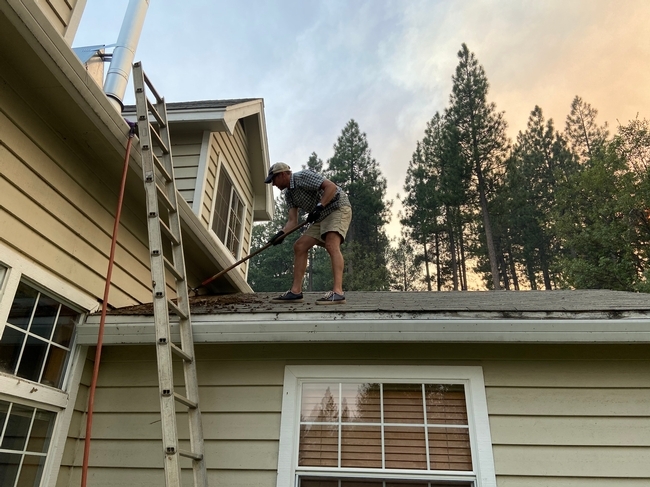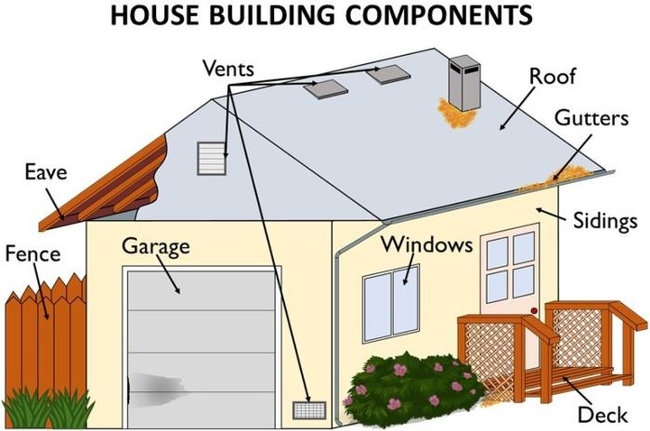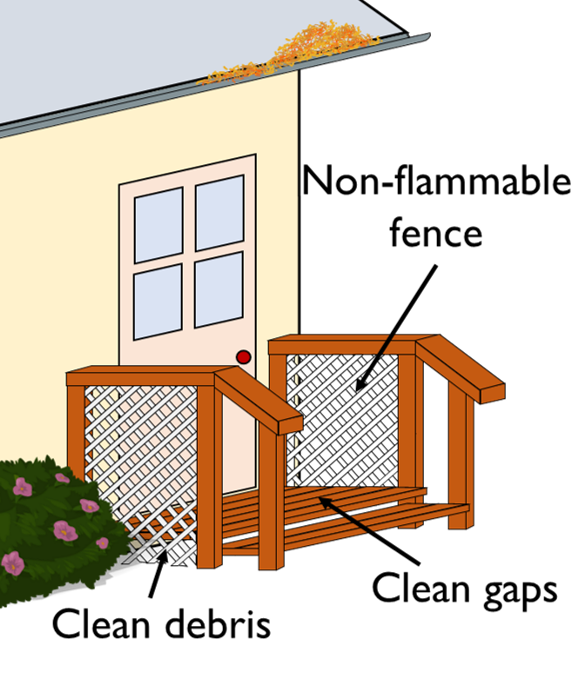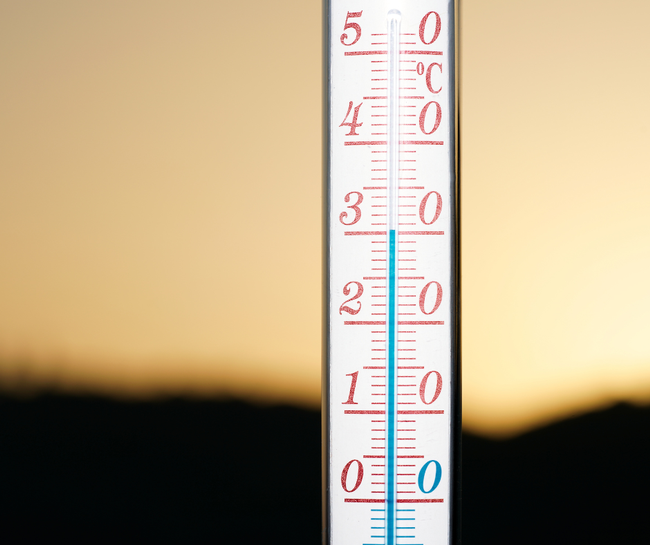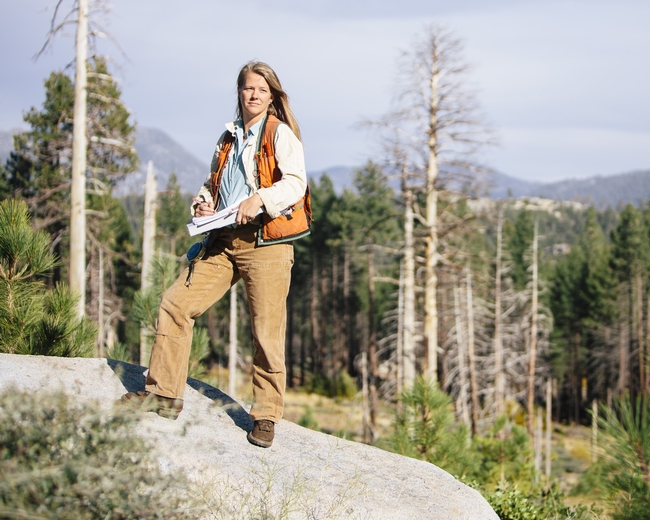
Posts Tagged: disaster
Five things you can do this weekend to help protect your home from wildfire
Despite recent rains, fire remains a danger across California, as there's still plenty of time this fall for grass, woody debris and other flammable material to become dry and ignite.
“The smaller the fuels – pine needles, grass, and small twigs – the faster they can dry out, meaning they will be ready to burn again a few days or weeks after a large rainstorm,” said Susie Kocher, a UC Cooperative Extension forestry and natural resources advisor for the Central Sierra, urging residents to take steps to prevent or limit potential fire damage.
When it comes to “home hardening” and essential wildfire preparations in this age of drought and climate change, not every project requires a bank-breaking budget and an army of contractors.
There are small – but significant – home and landscaping improvements that most people can complete by themselves during a single weekend, with a quick run to the hardware store and some basic planning and safety precautions.
“There are a lot of factors that play into your home's vulnerability to ignition; small changes and upgrades can help reduce some of that risk for people living in high wildfire risk areas,” Kocher explained. “The bigger projects like replacing windows and roofs are very important, but there are definitely smaller projects that people can tackle right away at lower cost that also reduce risk. The main goal of these actions is to reduce the risk that wildfire embers can ignite your home.”
Kocher recommends these five measures as simple but crucial ways to bolster your home's wildfire resiliency.
Clean debris from your roof. Because of its expansive surface, the roof is the most susceptible area of your house to embers. Removing accumulated leaves and needles is especially important if you have a “complex roof” with dormers or other elements – that's where embers gather, too, and could come in contact with flammable siding. (And while you're up there, give those gutters a good swabbing.) Learn more about protecting your roof and gutters.
Install metal flashing in vulnerable spots. Replacing all your siding with noncombustible material can be pricey, but a more manageable task would be adding corrosion-resistant metal flashing to select areas: roof-to-wall intersections, the place where the chimney comes out of the roof, and the edge where the deck meets the house. Learn other ways to shore up your siding.
Remove debris from between the boards of your deck and fence. Embers can ignite leaves and needles stuck between the boards, so be sure to keep those gaps clean and clear. Learn additional steps to harden your deck and prepare your fence.
Take out all vegetation (alive or dead) within five feet of your home. Creating defensible space immediately next to your home is a top priority, so be sure there's nothing combustible within this “Zone Zero.” Plants, mulch, woodpiles, wicker furniture or anything that can catch fire should be removed. Learn what to do in the other “zones” as you move farther from your home.
Inspect vents and upgrade to finer mesh screens. Install or swap in noncombustible, corrosion-resistant metal mesh screening that is at least 1/8” (1/16” would be even better but requires more frequent maintenance). These screens help prevent embers from entering your attic and crawl space. In addition, put together some vent covers that can be deployed if you have time before a wildfire arrives. Learn other ways to reduce vulnerability of vents.
For more in-depth explanations and next steps, Kocher suggests visiting the UC ANR wildfire website (https://ucanr.edu/sites/fire/Prepare) and reviewing this home retrofit guide (https://bit.ly/3RaL54u).
Disaster resources available to prepare for heat, wildfire, power outages, quakes
September is National Preparedness Month, designated to encourage disaster and emergency readiness. To help Californians prepare for extreme heat, earthquakes, public safety power shutoffs and wildfire, University of California Cooperative Extension has created a disaster preparedness website organized for quick access to critical information.
The website https://ucanr.edu/Disaster contains fact sheets with tips for getting prepared.
“Unfortunately, with a warming climate, we are facing more and more extreme climate-related events such as heat waves, wildfires, power shutoffs and storms. All Californians need to step up their preparedness efforts to be ready to meet this more uncertain future,” said Susan Kocher, UC Cooperative Extension forestry advisor, who co-authored the disaster preparedness resources for the website.
Extreme heat
The fact sheet for extreme heat events offers suggestions for avoiding heat exposure, such as identifying nearby cooling centers and covering windows to keep heat out. It also suggests things to do during hot weather such as staying hydrated, taking cool showers and keeping pets indoors. It describes symptoms of heat-related illnesses, which can have serious health effects.
Public Safety Power Shutoff
During extreme weather events, electrical power in high fire-threat areas may be shut off to prevent sparking. This precaution is known as a Public Safety Power Shutoff. A PSPS is most likely to occur from May to November, when conditions are the hottest and driest.
UC Cooperative Extension recommends signing up to receive PSPS alerts from your energy company. Experts also advise making a plan for medications that need to be refrigerated or medical devices that require power. To prevent foodborne illness, they offer suggestions for ensuring food safety during and after a power outage.
Wildfire and smoke
Wildfire smoke can harm your health. During wildfires, UC Cooperative Extension recommends wearing an N95 outdoors to reduce smoke exposure and taking steps to prevent smoke from entering buildings. To reduce wildfire risk, the website describes methods of removing flammable vegetation around homes.
Earthquakes
UC Cooperative Extension offers safety tips for before, during and after an earthquake. Identifying the safest place in your home during an earthquake in advance is helpful. For example, doorways are not the safest place to be in modern homes. Experts recommend crawling under a sturdy desk or table, while avoiding areas next to windows, beneath ceiling fixtures or near large items that may fall during an earthquake.
The website also offers resources on drought, food safety after a fire, and wildfire preparedness and recovery.
In 2020 and 2021, Cooperative Extension researchers from around the country held listening sessions with community members who had experienced extreme weather events and other types of disasters to learn what had worked well, what had not, and how communities could be strengthened.
In response, these disaster resources were developed by Kocher, UC Davis undergraduate student Caydee Schweitzer, Tracy Schohr, UC Cooperative Extension livestock and natural resource advisor, and Vikram Koundinya, UC Cooperative Extension evaluation specialist. The group plans to add fact sheets on more disaster topics in the future.
This project was funded by a USDA National Institute of Food and Agriculture Renewable Resources Extension Act grant.
MEDIA CONTACT: Susan Kocher, UC Cooperative Extension forestry advisor, sdkocher@ucanr.edu
USDA Expands Assistance to Cover Feed Transportation Costs for Drought-Impacted Ranchers
News from USDA. Also check out the Livestock Forage Program (LFP) at: https://www.fsa.usda.gov/Assets/USDA-FSA-Public/usdafiles/FactSheets/livestock_forage_program_lfp-fact_sheet.pdf
WASHINGTON, September 8, 2021— In response to the severe drought conditions in the West and Great Plains, the U.S. Department of Agriculture (USDA) announced today its plans to help cover the cost of transporting feed for livestock that rely on grazing. USDA is updating the Emergency Assistance for Livestock, Honey Bees and Farm-raised Fish Program (ELAP) to immediately cover feed transportation costs for drought impacted ranchers. USDA's Farm Service Agency (FSA) will provide more details and tools to help ranchers get ready to apply at their local USDA Service Center later this month at fsa.usda.gov/elap.
“USDA is currently determining how our disaster assistance programs can best help alleviate the significant economic, physical and emotional strain agriculture producers are experiencing due to drought conditions,” said Agriculture Secretary Tom Vilsack. “The duration and intensity of current drought conditions are merciless, and the impacts of this summer's drought will be felt by producers for months to come. Today's announcement is to provide relief as ranchers make fall and winter herd management decisions.”
ELAP provides financial assistance to eligible producers of livestock, honeybees, and farm-raised fish for losses due to disease, certain adverse weather events or loss conditions as determined by the Secretary of Agriculture.
ELAP already covers the cost of hauling water during drought, and this change will expand the program beginning in 2021 to cover feed transportation costs where grazing and hay resources have been depleted. This includes places where:
- Drought intensity is D2 for eight consecutive weeks as indicated by the U.S. Drought Monitor;
- Drought intensity is D3 or greater; or
- USDA has determined a shortage of local or regional feed availability.
Cost share assistance will also be made available to cover eligible cost of treating hay or feed to prevent the spread of invasive pests like fire ants.
Under the revised policy for feed transportation cost assistance, eligible ranchers will be reimbursed 60% of feed transportation costs above what would have been incurred in a normal year. Producers qualifying as underserved (socially disadvantaged, limited resource, beginning or military veteran) will be reimbursed for 90% of the feed transportation cost above what would have been incurred in a normal year.
A national cost formula, as established by USDA, will be used to determine reimbursement costs which will not include the first 25 miles and distances exceeding 1,000 transportation miles. The calculation will also exclude the normal cost to transport hay or feed if the producer normally purchases some feed. For 2021, the initial cost formula of $6.60 per mile will be used (before the percentage is applied), but may be adjusted on a state or regional basis.
To be eligible for ELAP assistance, livestock must be intended for grazing and producers must have incurred feed transportation costs on or after Jan. 1, 2021. Although producers will self-certify losses and expenses to FSA, producers are encouraged to maintain good records and retain receipts and related documentation in the event these documents are requested for review by the local FSA County Committee. The deadline to file an application for payment for the 2021 program year is Jan. 31, 2022.
Additional USDA Drought Assistance
USDA has authorized other flexibilities to help producers impacted by drought. USDA's Risk Management Agency (RMA) extended deadlines for premium and administrative fee payments and deferred and waived the resulting interest accrual to help farmers and ranchers through widespread drought conditions in many parts of the nation. Additionally, RMA authorized emergency procedures to help streamline and accelerate the adjustment of losses and issuance of indemnity payments to crop insurance policyholders in impacted areas and updated policy to allow producers with crop insurance to hay, graze or chop cover crops at any time and still receive 100% of the prevented planting payment. This policy change supports use of cover crops, which improves soil health can help producers build resilience to drought.
Meanwhile, USDA's Natural Resources Conservation Service (NRCS) provides technical and financial assistance to improve irrigation efficiency and water storage in soil, helping producers build resilience to drought. In response to drought this year, NRCS targeted $41.8 million in Arizona, California, Colorado and Oregon through Conservation Incentive Contracts, a new option available through the Environmental Quality Incentives Program, focused on drought practices.
USDA offers a comprehensive portfolio of disaster assistance programs. On farmers.gov, the Disaster Assistance Discovery Tool, Disaster Assistance-at-a-Glance fact sheet, and Farm Loan Discovery Tool can help producers and landowners determine all program or loan options available for disaster recovery assistance.
More Information
More information on this expansion to ELAP is forthcoming. In the meantime, more information is available at fsa.usda.gov/elap or by contacting a local USDA Service Center.
USDA Informational Meeting Tuesday, May 15
The Farm Service Agency offices in Klamath, Modoc and Siskiyou counties are planning an informational meeting on Tuesday May 15. The meeting will begin at 10 a.m. at the Merrill Civic Center 365 Front Street, Merrill Oregon. Topics include reporting requirements needed to maintain eligibility for...
Farm Service Agency Meeting May15

